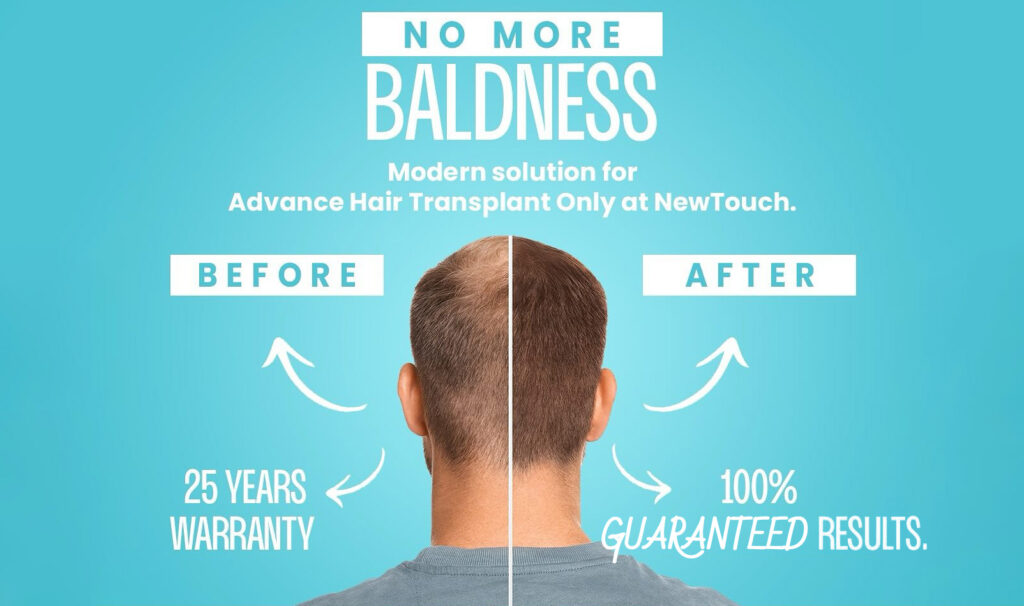108, Shangrila Arcade,
Nr. Shyamal Cross Road,
Satellite, Ahmedabad - 380015

At New Touch, we believe hair restoration is a step toward renewed self-esteem and lasting transformation. Our experienced team uses advanced methods to ensure safe and natural-looking results. Each procedure is performed with careful attention and modern tools for effective outcomes. We are proud to be recognized as a leading Ahmedabad hair transplant clinic. From initial consultation to post-treatment care, we support our clients at every step. Many trust us for visible improvement and long-term satisfaction. People across the city visit us for the best hair treatment in Ahmedabad. For expert advice and care, consult our trusted Ahmedabad hair specialist doctor today.
Schedule a consultation and take the first step towards a fuller head of hair with New Touch Hair Restoration clinic.
25 years warranty with 100% guaranteed results.
Hair loss does not happen overnight and is usually caused by a mix of different factors. Genetics is one of the most common reasons, especially in male and female pattern baldness. Hormonal imbalances, certain medical conditions, and medications can lead to thinning hair. Stress, poor diet, and lack of proper sleep often make the problem worse. Harmful lifestyle habits like smoking or using harsh hair products can also affect hair health. Even wearing tight hairstyles regularly can cause long-term damage. Finding the exact reason is the key to solving the issue. That is why we work on identifying the true cause of your hair loss.
At New Touch, we use advanced methods like Follicular Unit Extraction (FUE) and Follicular Unit Transplantation (FUT) to restore natural hair growth. These techniques involve removing healthy hair follicles and implanting them in thinning or bald areas. We aim for results that blend in with your natural hairline and texture. The process is done with care to reduce discomfort and recovery time. Our approach has made us a trusted Ahmedabad hair transplant clinic for safe and reliable outcomes.
Each case is handled with a personalized plan after understanding the pattern and reason behind hair loss. Our specialists evaluate your scalp health, hair density, and expectations before starting the process. The goal is to deliver long-lasting, visible improvements without overcomplicating the process. If you’re looking for the best hair treatment in Ahmedabad, we are here to guide you. Book a consultation with an experienced Ahmedabad hair specialist doctor to explore the right treatment for your needs.
Hair loss affects both men and women, and at New Touch, we offer effective solutions for everyone. Men commonly experience pattern baldness, while women may face thinning hair due to hormonal changes or stress. Our methods focus on restoring hair naturally, paying attention to gender-specific needs. We ensure each transplant blends well with existing hair for a balanced look. If you want the best hair treatment in Ahmedabad, we provide expert care for all hair types and conditions.
Our team works closely with every patient to understand their unique hair loss pattern and goals. We carefully plan the transplant to achieve the most natural and long-lasting results. Women and men alike benefit from our skilled approach, guided by an experienced Ahmedabad hair specialist doctor. The process is straightforward and supported by continuous care for healthy hair growth. Confidence grows as your hair restores, and life moves forward with renewed energy.
At New Touch, we focus on real results and patient satisfaction through every step of the hair transplant process. Our goal is to make hair restoration simple, effective, and comfortable.
Experienced Team
Our team includes skilled professionals with years of experience in performing successful hair transplants. Every procedure is done with care and attention to detail.
Modern Techniques
We use advanced methods like FUE and FUT to ensure natural-looking outcomes. These techniques help reduce recovery time and improve long-term results.
Personalized Approach
Each patient receives a treatment plan based on their hair type, condition, and goals. This helps in achieving results that suit individual needs.
Transparent Care
From consultation to recovery, we keep everything clear and honest. Our team is always available to answer questions and guide you at every step.
At New Touch, we follow a clear and careful process to ensure the best results for every hair transplant. Our step-by-step approach is focused on safety, comfort, and natural-looking outcomes.
Consultation and Assessment
We begin by understanding your hair loss pattern and health history. This helps us create the most suitable plan for your needs.
Preparation and Planning
Before the procedure, we prepare your scalp and discuss the treatment details. This ensures you feel confident and informed.
Hair Transplant Procedure
Using advanced techniques, healthy hair follicles are carefully extracted and implanted. The process aims for natural growth and minimal discomfort.
Post-Procedure Care
After the transplant, we provide detailed instructions and support for recovery. Regular follow-ups help track progress and maintain hair health.
For expert care and trusted solutions, reach out to New Touch, the leading Ahmedabad hair transplant clinic. Get in touch today to experience the best hair treatment in Ahmedabad and start your journey to renewed confidence.
The cost depends on the number of grafts needed and the technique used. We provide a personalized quote after a thorough consultation to ensure you get the best value. Our pricing is competitive within the Ahmedabad hair transplant clinic market.
We use local anesthesia to numb the scalp, so you should feel minimal to no pain during the procedure. Some slight discomfort or soreness may occur after, but it is manageable with prescribed care.
You can easily schedule an appointment by calling our clinic or using the online booking form available on our website. Early booking is recommended due to high demand.
Please contact us as soon as possible to reschedule. We understand emergencies happen and will work with you to find a convenient alternative time without losing your spot.
Yes, the consultation is crucial to assess your hair loss condition and health background. It helps us recommend the most effective treatment plan customized for you.
Yes, the transplanted hair follicles are usually permanent as they come from donor areas resistant to hair loss. Over time, these hairs grow naturally and blend seamlessly with existing hair.
